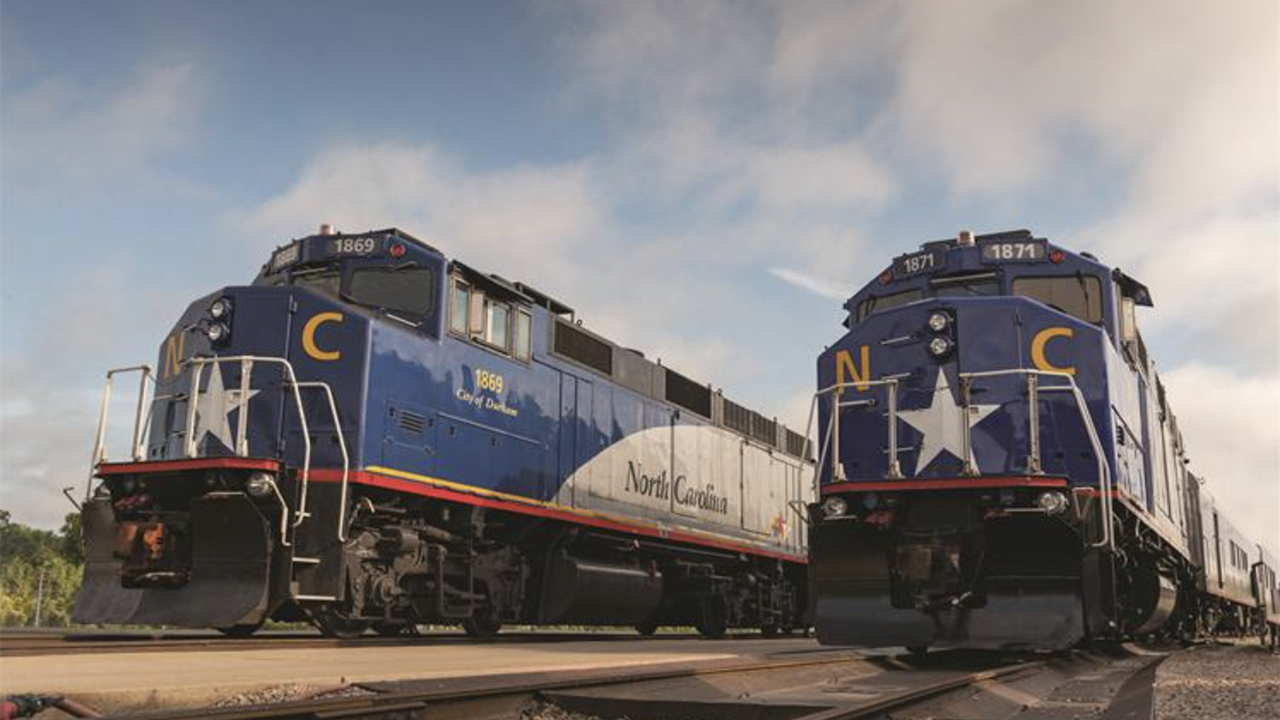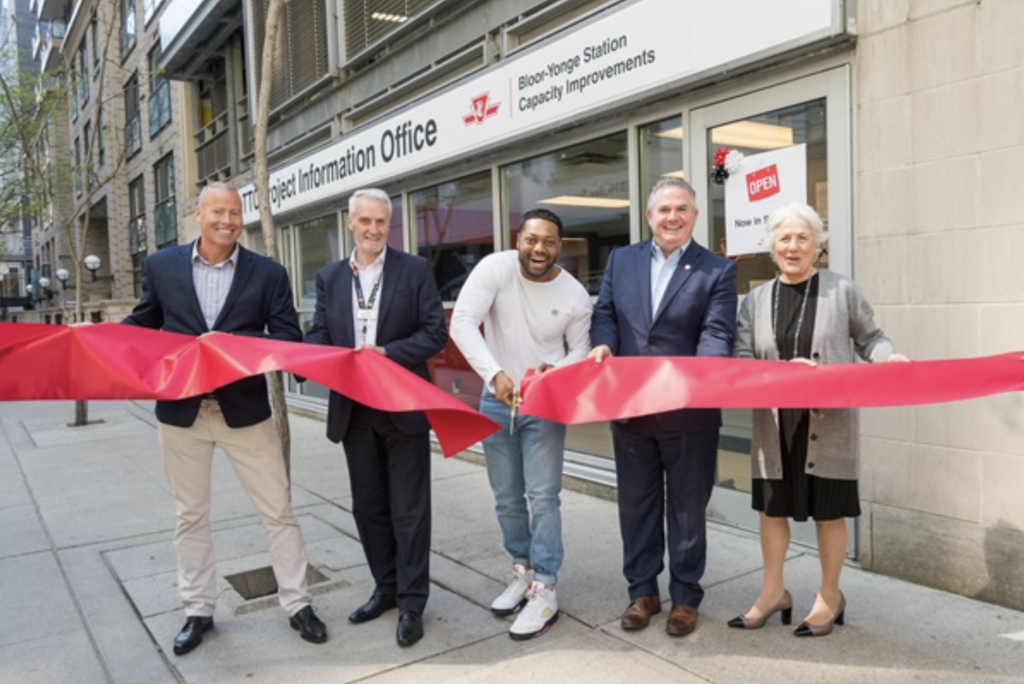
Transit Briefs: Amtrak, CTA, TransLink/TTC, WMATA
Written by Marybeth Luczak, Executive Editor
A daily roundtrip will be added to the Piedmont starting July 10, according to Amtrak, which operates the intercity passenger train for NCDOT. (NCDOT Photograph)
Amtrak and the North Carolina Department of Transportation (NCDOT) are boosting Piedmont service between Charlotte and Raleigh. Also, Chicago Transit Authority’s (CTA) Transit-Supportive Development Plan for the Red Line Extension project has been adopted; Toronto Transit Commission (TTC) and Vancouver’s TransLink wrap up a pilot testing the effectiveness of antimicrobial copper coatings on high-touch vehicle services; TTC opens a community office ahead of construction at the Bloor-Yonge Station; and Washington Metropolitan Area Transit Authority (WMATA) celebrates the grand opening of its 98th station.
A daily roundtrip will be added to the Piedmont starting July 10, according to Amtrak, which operates the intercity passenger train for NCDOT. Riders will have 10 trips daily to choose from between Raleigh and Charlotte. The Piedmont also stops in Cary, Durham, Burlington, Greensboro, High Point, Salisbury and Kannapolis.
“The trend of increased ridership over the last year has shown the need for new service options,” NCDOT Rail Division Director Jason Orthner said.
NCDOT achieved record first-quarter 2023 ridership for its NC By Train service—comprising the Amtrak Carolinian and Piedmont trains. The trains carried 135,000-plus riders, up more than 30% from the same period in 2019 (pre-pandemic) and up more than 50% from the same period in 2022. In April, NC By Train had its second highest ridership month with more than 53,300 riders.
The Piedmont service will now provide riders with:
- A new 1 p.m. mid-day departure from Raleigh.
- A new 5:30 p.m. departure from Charlotte.
- Earlier afternoon departure at 2:20 p.m. from Charlotte.
- Later evening departure at 7:45 p.m. from Charlotte.
- Scheduled trip times of just under three hours for the 6:30 a.m. departure from Raleigh and the 5:30 p.m. departure from Charlotte.
The Chicago Plan Commission on May 18 adopted the Red Line Extension’s Transit-Supportive Development Plan (see above). Led by CTA in partnership with Chicago’s Department of Planning and Development (DPD), the plan will serve as a “guide for the future development of the long-disinvested communities” that are located near the Red Line Extension project, according to the transit agency.
The Red Line is CTA’s most traveled rapid transit line, offering 24-hour service between Howard on the North Side and 95th/Dan Ryan on the South Side. It will be extended 5.6 miles from the existing southern terminal at 95th Street to 130th Street, adding four new, fully accessible rail stations near 103rd Street, 111th Street, Michigan Avenue, and 130th Street. (CTA recently selected three prequalified teams to submit proposals for the $3.6 billion Red Line Extension project.)
The Transit-Supportive Development Plan addresses increasing residential development, variety and affordability; strengthening commercial, retail and mixed-use development; and encouraging economic development and employment generators; as well as public space and greater transportation access.
“The plan provides a community-driven framework for equitable transit-oriented improvements around the future stations, along with other Far South Side development opportunities that will create stronger, more equitable neighborhoods,” DPD Commissioner Maurice Cox said.
Canadian mining company Teck on May 18 reported that a one-year study led by the medical microbiology research team at Vancouver Coastal Health and hosted by TTC and TransLink, found that select copper products on public transit can eliminate up to 99.9% of bacteria.
The study, announced in 2021 and funded by Teck, evaluated the efficacy of three copper-based solutions for reducing the transmission of bacteria and viruses on high-touch surfaces on public transportation (see video above). The solutions tested included thermal-coated copper surface layers, copper alloys, and copper decals on handles and exit doors on buses, streetcars and trains; both in-situ for bacterial testing and in-lab for virus testing. Test results showed that select copper products can eliminate up to 99.9% of bacteria on public transit and 99.9% of viruses in a laboratory setting within two hours of contact, according to Teck.
“Led by the Vancouver Coastal Health medical microbiology team, researchers tested for virus-killing capabilities, including surrogates for COVID-19 and Noroviruses,” Teck reported. “This testing is crucial, as it demonstrates the potential for copper surfaces to reduce the risk of transmission of viruses in addition to bacteria. Results of the in-laboratory studies showed consistent viral load reduction for surrogates of COVID-19 and Noroviruses, as well as the bacterial testing, across all copper products compared to no reduction in the stainless steel comparison.”
According to Teck, samples were analyzed every two months, from copper surfaces as well as non-copper surfaces on transit by Vancouver Coastal Health’s medical microbiology team, supported by Mount Sinai Hospital/University Health Network in Toronto and the University of British Columbia in Vancouver. Researchers from the University of British Columbia tested and analyzed the durability of the three products as they aged over the course of the year. In-lab virus and bacterial testing simulated a year’s worth of use, including disinfectant cleaning and human touch (sweat). The copper products showed consistent and sustained antimicrobial activity through the course of the testing, showing that cleaners and human use did not affect the efficacy of the copper in killing surface bacteria and viruses, according to Teck.
“The findings have significant implications for public health, especially during pandemics and outbreaks, and highlight the importance of interdisciplinary collaborations between health care providers, academic researchers, and industry partners in improving infection control measures,” Teck reported. “The success of this pilot project demonstrates the efficacy of copper surfaces in reducing the spread of bacteria and viruses in shared public spaces.”
“TransLink is proud to be the first transit agency in North America to welcome healthcare providers and academic researchers onto our system to test copper on transit vehicles,” TransLink CEO Kevin Quinn said. “We hope this innovative partnership will help to broaden the scientific community’s understanding of copper and its use in public spaces.”
“This study provides another proof point that copper, alongside hand washing, vaccination programs and other infection prevention measures, is an added layer that can help reduce the risk of transmission of pathogens,” said Dr. Marthe Charles, Medical Microbiologist at Vancouver Coastal Health. “We’re excited that we have been able to contribute to the global understanding of the antibacterial and antiviral properties of copper and that was made possible through this partnership.”

A community office for TTC’s Bloor-Yonge Capacity Improvements Project officially opened on May 17. The office provides a place for community members to meet with TTC project staff, ask questions, and address concerns related to the upcoming expansion and rehabilitation of the TTC’s Bloor-Yonge Subway Station.
In December 2022, the federal, provincial and municipal governments announced joint funding of up to C$1.5 billion for the project, which includes construction of a second platform on Line 2 for eastbound service; an expansion of the Line 1 northbound and southbound platforms; new elevators, escalators and stairs; and construction of a new accessible entrance and exit on Bloor St. E. AECOM will provide consulting services through all project phases, including detailed design, procurement, construction, commissioning, handover and close-out.
“The opening of this office marks the first step in important improvements to Bloor-Yonge Station and TTC service through the area,” TTC CEO Rick Leary said. “We know construction can be challenging, and the support of the local community is invaluable to this project. I encourage local residents and businesses to come out, meet the project team, and provide any feedback on this project to the TTC.”
WMATA on May 19 celebrated the launch of its Potomac Yard-VT station in Alexandria, Va., following more than three years of construction (see video above). Located on the Blue and Yellow lines between the Ronald Reagan Washington National Airport and Braddock Road stations, it is WMATA’s 98th station and second infill station since NoMa-Gallaudet U. The first Yellow Line train made its inaugural stop at 5:08 a.m.
WMATA General Manager Randy Clarke and Board Chair Paul C. Smedberg, Alexandria Mayor Justin Wilson, and other federal, state and local officials participated in the grand opening ceremony, which was attended by nearly 600 people.
The station provides riders with access to Metroway and Alexandria DASH bus service and to a Bike & Ride facility. While it does not have parking facilities, the station is accessible via two pavilions, one on the north side and another to the south. Additionally, there are walking paths to it from the surrounding area.
Built to LEED Silver green building standards, the station offers energy efficient lighting and water use systems, used low emitting and recycled materials in construction, and employs rainwater management to help preserve local wetlands, according to WMATA. Artwork featured on the exterior of the two entrance pavilions recognizes the station’s Virginia roots and the proximity to the nation’s capital, the agency added. Created by artist Rob Ley, the south pavilion features a representation of Virginia blue bells with the famed cherry blossoms on the north pavilion.
The station project was initiated by the city of Alexandria and funded by tax revenues, developer contributions, federal and state grants, loans, and regional sources. It anchors new development in the surrounding community, including housing, retail, commercial space and the new Virginia Tech Innovation Campus expected to open next year.
“The opening of the new Potomac Yard Station is an exciting Metro [WMATA] milestone that’s been 40 years in the making so congratulations to all who made this a reality,” Paul C. Smedberg said. “The station, located in the fastest growing area of Alexandria, enhances connectivity to and from the city, which has seen substantial population growth and new development in the last few decades. As a proud Alexandrian, I know firsthand the Potomac Yard Station will provide numerous benefits for Alexandria and surrounding communities, including walkable access to regional transportation systems. The station is expected to … eventually support more than 26,000 new jobs and 13,000 new residents.”
“The Potomac Yard Station is going to be an economic driver for Alexandria’s future, spurring billions of dollars in private-sector investment over the long term and supporting new jobs, making Virginia a better place to work and live,” said Jennifer DeBruhl, Director of the Virginia Department of Rail and Public Transportation. “The new Metro [WMATA] station was a key component in attracting Amazon’s second headquarters and locating the new Virginia Tech Innovation Campus to the area.”



